Unit 2 I'll help to clean up the city parks. 单元复习课件(共35张PPT)
文档属性
| 名称 | Unit 2 I'll help to clean up the city parks. 单元复习课件(共35张PPT) | 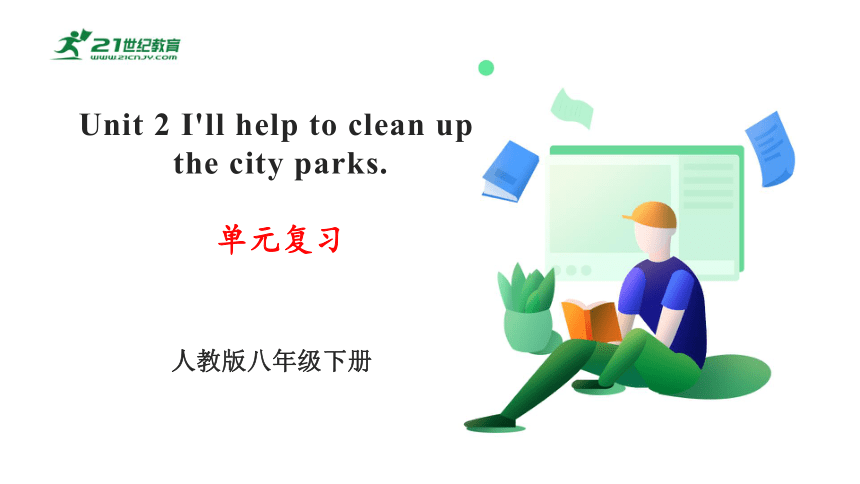 | |
| 格式 | pptx | ||
| 文件大小 | 837.7KB | ||
| 资源类型 | 试卷 | ||
| 版本资源 | 人教新目标(Go for it)版 | ||
| 科目 | 英语 | ||
| 更新时间 | 2023-05-29 14:24:40 | ||
图片预览

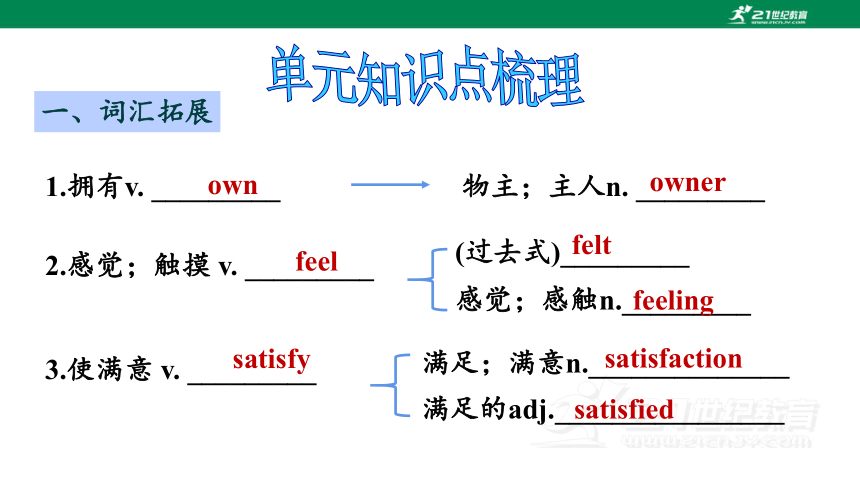
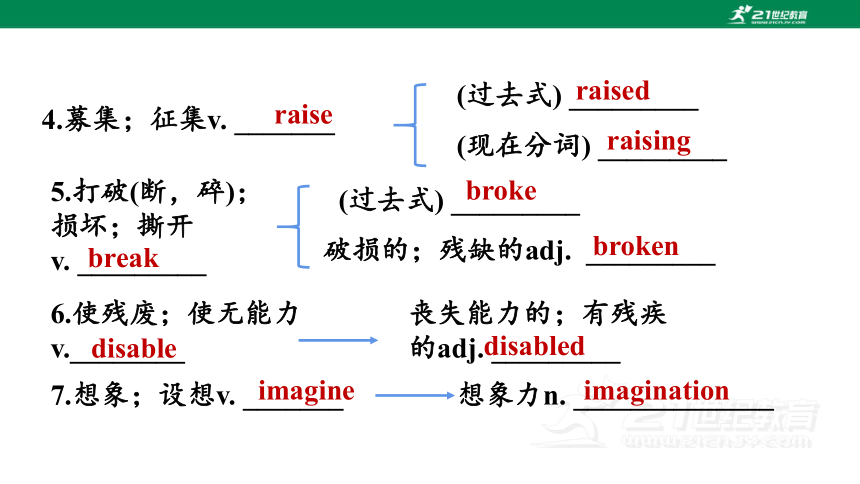
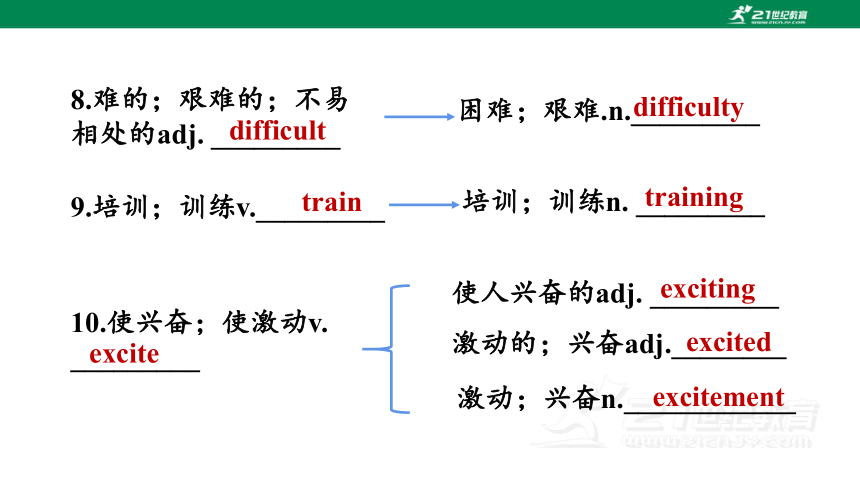

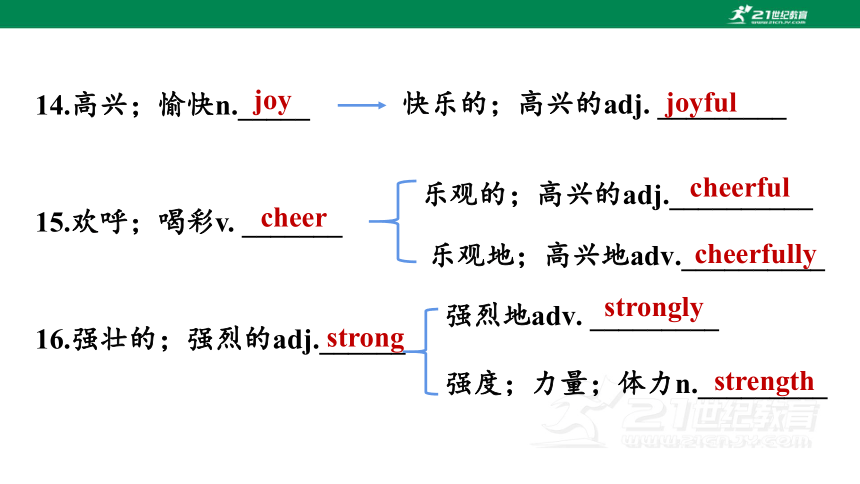
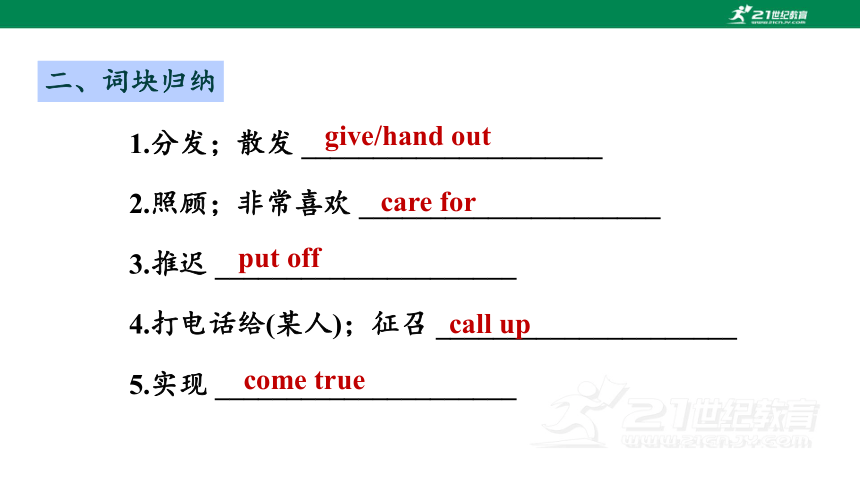
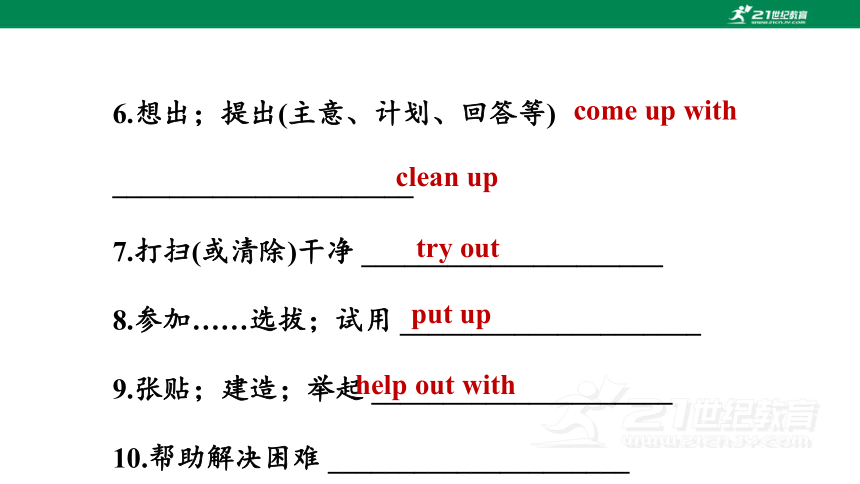
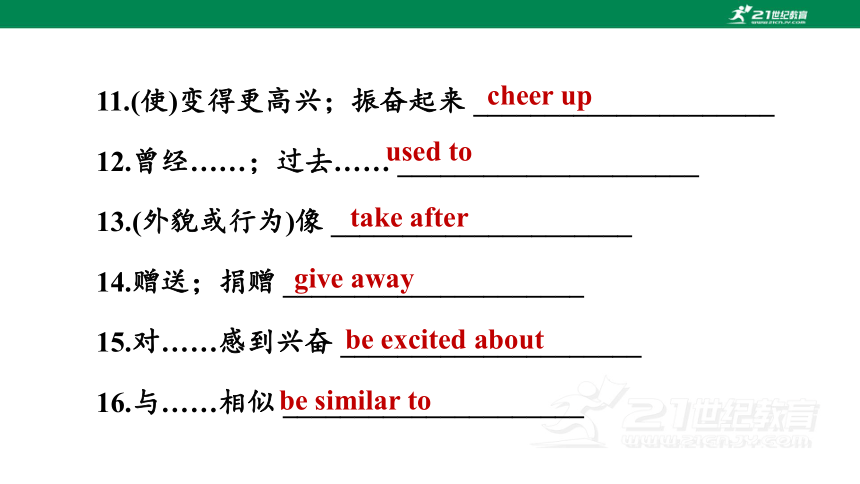

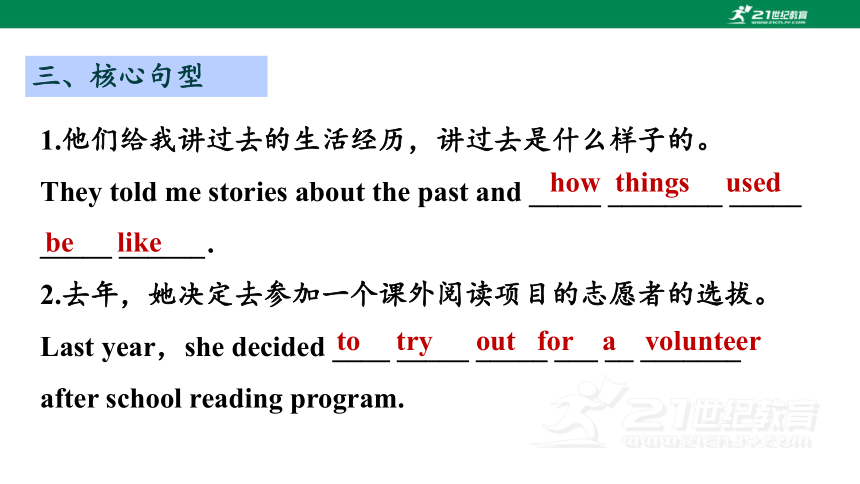
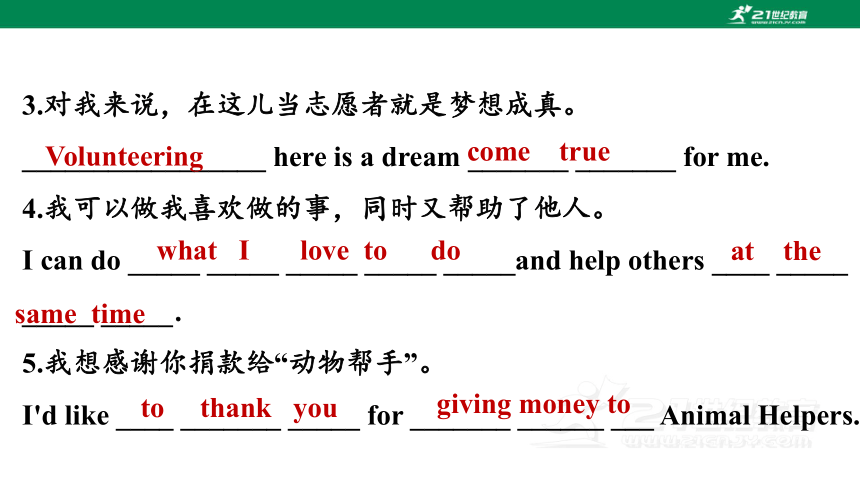
文档简介
(共35张PPT)
Unit 2 I'll help to clean up
the city parks.
单元复习
人教版八年级下册
单元知识点梳理
一、词汇拓展
1.拥有v. _________
物主;主人n. _________
(过去式)_________
感觉;感触n._________
满足;满意n.______________
满足的adj.________________
2.感觉;触摸 v. _________
3.使满意 v. _________
own
owner
feel
felt
feeling
satisfy
satisfaction
satisfied
4.募集;征集v. _______
(过去式) _________
(现在分词) _________
(过去式) _________
6.使残废;使无能力v.________
丧失能力的;有残疾的adj. _________
想象力n. ______________
5.打破(断,碎); 损坏;撕开
v. _________
破损的;残缺的adj. _________
7.想象;设想v. _______
raise
raised
raising
break
broke
broken
disable
disabled
imagine
imagination
8.难的;艰难的;不易相处的adj. _________
困难;艰难.n._________
10.使兴奋;使激动v. _________
使人兴奋的adj. _________
激动的;兴奋adj.________
9.培训;训练v._________
培训;训练n. _________
difficult
difficulty
train
training
excite
exciting
excited
excitement
激动;兴奋n.____________
11.友好的adj. _________
仁慈;善良n. _________
(过去式)______________
善解人意的adj._____________
有趣的adj. _____________
感兴趣的adj._____________
12.理解;领会v. __________
13.兴趣;关注n.
使感兴趣;使关注v._________
kind
kindness
understand
understood
understanding
interest
interesting
interested
14.高兴;愉快n._____
快乐的;高兴的adj. _________
乐观地;高兴地adv.__________
强烈地adv. _________
强度;力量;体力n._________
15.欢呼;喝彩v. _______
16.强壮的;强烈的adj.______
joy
joyful
cheer
cheerful
cheerfully
strong
strongly
strength
乐观的;高兴的adj.__________
二、词块归纳
1.分发;散发 _____________________
2.照顾;非常喜欢 _____________________
3.推迟 _____________________
4.打电话给(某人);征召 _____________________
5.实现 _____________________
give/hand out
care for
put off
call up
come true
6.想出;提出(主意、计划、回答等) _____________________
7.打扫(或清除)干净 _____________________
8.参加……选拔;试用 _____________________
9.张贴;建造;举起 _____________________
10.帮助解决困难 _____________________
come up with
clean up
try out
put up
help out with
11.(使)变得更高兴;振奋起来 _____________________
12.曾经……;过去…… _____________________
13.(外貌或行为)像 _____________________
14.赠送;捐赠 _____________________
15.对……感到兴奋 _____________________
16.与……相似 _____________________
cheer up
used to
take after
give away
be excited about
be similar to
17.建起;设立 _____________________
18.对……有很大影响________________________
19.立刻;马上 _____________________
20.修理;装饰 _____________________
21.擅长 _____________________
22.能够 _____________________
set up
make a big difference to
at once
fix up
be strong in
be able to
三、核心句型
1.他们给我讲过去的生活经历,讲过去是什么样子的。
They told me stories about the past and _____ ________ _____ _____ ______.
2.去年,她决定去参加一个课外阅读项目的志愿者的选拔。
Last year,she decided ____ _____ _____ ___ __ _______
after school reading program.
how things used
be like
to try out for a volunteer
3.对我来说,在这儿当志愿者就是梦想成真。
_________________ here is a dream _______ _______ for me.
4.我可以做我喜欢做的事,同时又帮助了他人。
I can do _____ _____ _____ _____ _____and help others ____ _____ _____ _____.
5.我想感谢你捐款给“动物帮手”。
I'd like ____ _______ _____ for _______ ______ ___ Animal Helpers.
Volunteering
come true
what I love to do
at the
same time
to thank you
giving money to
6.我确信你知道这个组织是为了帮助像我这样的残疾人而建立的。
_____ _____you know that this group was set up ___ _____ ________ ________ like me.
7.有了你的帮助,我才有可能拥有“幸运儿”。
You helped to _____ ___ ________ ___ __ ___ _____ Lucky.
I’m sure
to help disabled
people
make it possible for me to have
8.成为盲人或听障人士会是什么样子?
What _______ ___ _____ _____ to be blind or deaf
9.如果你喜欢,我可以给你寄一张他的照片,让你看看他是如何帮助我的。
______ _______ you a photo of him _____ you like,and I could show you how he helps me.
would it be like
I’ll send
if
四、重难知识点归纳
1、The girl could visit the sick kids in the hospital to cheer them up.这个女孩可以去医院看望生病的孩子们,让他们高兴起来。
cheer up意为“(使)变得更高兴;振奋起来”。该短语为“动词+副词”结构。若是代词作宾语,代词应放在cheer和up之间。
【拓展延伸】
①cheer up也可单独使用,常用于口语中,用以鼓励对方振作起来。
②cheers为感叹词,用于祝酒,意为“干杯”。
③含up的常见短语:
call up打电话给(某人);征召
clean up打扫(或清除)干净
cut up切碎 dress up打扮;装饰
fix up修理;装饰 get up起床;站起
give up放弃 grow up成长;长大
make up编造 put up张贴;搭建
set up建起;设立 stay up熬夜
wake up弄醒;醒过来 take up 学着做;开始做
2、The boy could give out food at the food bank.
这个男孩可以去食物赈济处分发食物。
give out意为“分发;散发”。在此处相当于hand out,是“动词+副词”短语。
【拓展延伸】由give构成的常见短语:
give up放弃 give away捐赠
give off发出;放出 give in屈服
3、We need to come up with a plan to tell people about the city park clean-up.我们需要想出一个计划来告诉人们有关城市公园清洁的事情。
come up with意为“想出;提出(主意、计划等)”,为固定短语,相当于think up。
【同类归纳】“动词+up with”结构的短语:
catch up with赶上;追上
keep up with跟上;紧跟
put up with容忍;忍得住
end up with以……结束
4、We can't put off making a plan.
我们不能推迟制订计划。
put off意为“推迟”。该短语为“动词+副词”结构,通常指会议、活动等未能按预定时间举行。其后可跟名词、代词或动名词等作宾语。
【拓展延伸】与put相关的短语:
put on上演;穿上;(体重)增加 put up张贴;搭建;举起
put down放下;写下 put away放回原处;整理好
put out熄灭 put…into投入(时间、心思等);放入
5、Yeah,a lot of old people are lonely.
是的,许多老人都感到孤独。
【易混辨析】alone与lonely
alone 副词 独自;单独地 常作方式状语,修饰动作,相当于by oneself。
形容词 独自的;单独的 在句中作表语,不含感彩,表示客观状况(强调形体上的)。
lonely 形容词 孤独的;寂寞的 常作表语,也可作定语,强调内心的孤独,带有浓厚的感彩(强调感情上的)。
6、I get such a strong feeling of satisfaction…我产生出那么一种很强烈的满足感……
such意为“如此;这样”。在此作形容词。修饰单数名词时,放在不定冠词之前;若名词前有one,no,any,some,all等词修饰时,such放在这些词之后。
I never know such a man.我从不认识这样一个人。
There is no such thing.没有这么一回事。
【易混辨析】such与so
such
such+a/an(+形容词)+单数名词 such a(kind) boy
such+形容词+复数名词/不可数名词 such kind boys;such fine weather
so
so +形容词/副词 so good/carefully
so+形容词+a/ an+单数名词 so kind a boy
so+many/much/few/little+名词 so many books;so much work
satisfaction意为“满足;满意”,为不可数名词,其反义词是dissatisfaction。
【拓展延伸】
satisfaction(n.满意)→satisfy(v.使满意)→satisfied(adj.满意的) →satisfying(adj.令人满意的)
【常用搭配】
to one's satisfaction 使/令某人满意/满足
express one's satisfaction at/with 对……表示满意
with satisfaction满意地 satisfy one's needs满足某人的需要
be satisfied with 对……感到满意
be satisfied to do sth.对做某事感到满意
7、…or raise money for homeless people.……
或者为无家可归的人筹钱。
raise作及物动词,意为“筹集;募集”。
raise…for…意为“为……筹集……”。
【拓展延伸】raise的其他用法:
①(同lift)举起;抬起
raise one's hand 举起手
②养育;饲养;种植
raise a family 养家 raise sheep 养羊
③(同 set up)建立;竖起
raise a monument 建立一座纪念碑
④提高;升高
raise one's voice 提高声音
8、You helped to make it possible for me to have Lucky.
有了你的帮助,我才有可能拥有lucky。
make it+adj.+for sb.to do sth.意为“使做某事对某人来说……”,为常用结构,该结构中it作形式宾语,真正的宾语是后面的动词不定式短语。
His advice makes it easy for me to learn English.他的建议使得学英语对我来说简单了。
【拓展延伸】常用于这种结构的动词还有:think,find,believe,feel,consider,suppose等。
五、单元语法点回顾
短语动词
1.定义:短语动词是由动词加介词、副词或其他词构成的固定词组或习语(idioms),其作用和动词差不多。有些短语动词相当于及物动词,有些则相当于不及物动词。
2.类型及用法:
(1)动词+介词(+sb./sth.),相当于一个及物动词,它的宾语总是在介词之后。
如:look after, look at, listen to, take after等。
e.g. She takes after her father.
(2)动词+副词 既可以充当及物动词也可以充当不及物动词。
常见的动词+副词结构的短语有:put up, hand out, give out, call up, cheer up, put off, look up, turn on/off, get up等。此类短语动词后面接名词时,名词可以放在副词之后,也可以放在副词和动词之间。接代词时,只能放在动词和副词之间。
e.g. take off your coat或take your coat off.
e.g. He looks sad. Let’s cheer him up.
(3)动词+副词+介词,相当于一个及物动词,宾语总是位于介词之后。常见的有:come up with, run out of, look forward to等。
动词不定式的用法
动词不定式是由“to+动词原形”构成(有时可以不带to)。动词不定式的否定形式是“not+动词不定式”。在句子中不能充当谓语,没有人称和数的变化.动词不定式短语具有名词、形容词和副词等的功能,可在句中用做多种句子成分。
1. 不定式作主语
动词不定式作主语时,通常表示一个具体的、特定的行为,其谓语动词用单数形式。
注意:动词不定式作主语时,为避免句子头重脚轻,可以用it作形式主语,不定式做主语放在句末。
e.g. To learn a foreign language is very useful.
It’s very useful to learn a foreign language.
2. 不定式作宾语
常接动词不定式作宾语的动词有:
想要 拒绝 忘记 (want, refuse, forget)
需要 努力 学习 (need, try, learn)
选择 同意 帮助 (choose, agree, help)
希望 决定 开始 (hope/wish/expect, decide, begin/start)
3. 不定式作宾语补足语
常接动词不定式作宾补的动词有:ask, tell, want, teach, wish, help, warn, invite, encourage 等可以构成“...sb. (not) to do sth.”结构的动词。
e.g. The teacher always tells us not to swim in the river.
注意:在let, make, see, watch, hear, feel, notice, have等感官听觉动词或使役动词后面作宾语补足语的动词, 其不定式一般要省略动词不定式符号“to”。
e.g. Let the girl leave here now.
4. 不定式作定语
动词不定式做定语放在所修饰的名词的后面。
e.g. I have something important to say.
5. 不定式作状语
表示目的、原因、结果等。
e.g.They brought in photos of their families for me to look at.
6.“疑问词+不定式”用法:不定式前可带what, who, which, where, when, how等疑问词,这种不定式短语在句中多用做宾语。 e.g. He didn’t tell me where to go.
谢谢
21世纪教育网(www.21cnjy.com)
中小学教育资源网站
兼职招聘:
https://www.21cnjy.com/recruitment/home/admin
Unit 2 I'll help to clean up
the city parks.
单元复习
人教版八年级下册
单元知识点梳理
一、词汇拓展
1.拥有v. _________
物主;主人n. _________
(过去式)_________
感觉;感触n._________
满足;满意n.______________
满足的adj.________________
2.感觉;触摸 v. _________
3.使满意 v. _________
own
owner
feel
felt
feeling
satisfy
satisfaction
satisfied
4.募集;征集v. _______
(过去式) _________
(现在分词) _________
(过去式) _________
6.使残废;使无能力v.________
丧失能力的;有残疾的adj. _________
想象力n. ______________
5.打破(断,碎); 损坏;撕开
v. _________
破损的;残缺的adj. _________
7.想象;设想v. _______
raise
raised
raising
break
broke
broken
disable
disabled
imagine
imagination
8.难的;艰难的;不易相处的adj. _________
困难;艰难.n._________
10.使兴奋;使激动v. _________
使人兴奋的adj. _________
激动的;兴奋adj.________
9.培训;训练v._________
培训;训练n. _________
difficult
difficulty
train
training
excite
exciting
excited
excitement
激动;兴奋n.____________
11.友好的adj. _________
仁慈;善良n. _________
(过去式)______________
善解人意的adj._____________
有趣的adj. _____________
感兴趣的adj._____________
12.理解;领会v. __________
13.兴趣;关注n.
使感兴趣;使关注v._________
kind
kindness
understand
understood
understanding
interest
interesting
interested
14.高兴;愉快n._____
快乐的;高兴的adj. _________
乐观地;高兴地adv.__________
强烈地adv. _________
强度;力量;体力n._________
15.欢呼;喝彩v. _______
16.强壮的;强烈的adj.______
joy
joyful
cheer
cheerful
cheerfully
strong
strongly
strength
乐观的;高兴的adj.__________
二、词块归纳
1.分发;散发 _____________________
2.照顾;非常喜欢 _____________________
3.推迟 _____________________
4.打电话给(某人);征召 _____________________
5.实现 _____________________
give/hand out
care for
put off
call up
come true
6.想出;提出(主意、计划、回答等) _____________________
7.打扫(或清除)干净 _____________________
8.参加……选拔;试用 _____________________
9.张贴;建造;举起 _____________________
10.帮助解决困难 _____________________
come up with
clean up
try out
put up
help out with
11.(使)变得更高兴;振奋起来 _____________________
12.曾经……;过去…… _____________________
13.(外貌或行为)像 _____________________
14.赠送;捐赠 _____________________
15.对……感到兴奋 _____________________
16.与……相似 _____________________
cheer up
used to
take after
give away
be excited about
be similar to
17.建起;设立 _____________________
18.对……有很大影响________________________
19.立刻;马上 _____________________
20.修理;装饰 _____________________
21.擅长 _____________________
22.能够 _____________________
set up
make a big difference to
at once
fix up
be strong in
be able to
三、核心句型
1.他们给我讲过去的生活经历,讲过去是什么样子的。
They told me stories about the past and _____ ________ _____ _____ ______.
2.去年,她决定去参加一个课外阅读项目的志愿者的选拔。
Last year,she decided ____ _____ _____ ___ __ _______
after school reading program.
how things used
be like
to try out for a volunteer
3.对我来说,在这儿当志愿者就是梦想成真。
_________________ here is a dream _______ _______ for me.
4.我可以做我喜欢做的事,同时又帮助了他人。
I can do _____ _____ _____ _____ _____and help others ____ _____ _____ _____.
5.我想感谢你捐款给“动物帮手”。
I'd like ____ _______ _____ for _______ ______ ___ Animal Helpers.
Volunteering
come true
what I love to do
at the
same time
to thank you
giving money to
6.我确信你知道这个组织是为了帮助像我这样的残疾人而建立的。
_____ _____you know that this group was set up ___ _____ ________ ________ like me.
7.有了你的帮助,我才有可能拥有“幸运儿”。
You helped to _____ ___ ________ ___ __ ___ _____ Lucky.
I’m sure
to help disabled
people
make it possible for me to have
8.成为盲人或听障人士会是什么样子?
What _______ ___ _____ _____ to be blind or deaf
9.如果你喜欢,我可以给你寄一张他的照片,让你看看他是如何帮助我的。
______ _______ you a photo of him _____ you like,and I could show you how he helps me.
would it be like
I’ll send
if
四、重难知识点归纳
1、The girl could visit the sick kids in the hospital to cheer them up.这个女孩可以去医院看望生病的孩子们,让他们高兴起来。
cheer up意为“(使)变得更高兴;振奋起来”。该短语为“动词+副词”结构。若是代词作宾语,代词应放在cheer和up之间。
【拓展延伸】
①cheer up也可单独使用,常用于口语中,用以鼓励对方振作起来。
②cheers为感叹词,用于祝酒,意为“干杯”。
③含up的常见短语:
call up打电话给(某人);征召
clean up打扫(或清除)干净
cut up切碎 dress up打扮;装饰
fix up修理;装饰 get up起床;站起
give up放弃 grow up成长;长大
make up编造 put up张贴;搭建
set up建起;设立 stay up熬夜
wake up弄醒;醒过来 take up 学着做;开始做
2、The boy could give out food at the food bank.
这个男孩可以去食物赈济处分发食物。
give out意为“分发;散发”。在此处相当于hand out,是“动词+副词”短语。
【拓展延伸】由give构成的常见短语:
give up放弃 give away捐赠
give off发出;放出 give in屈服
3、We need to come up with a plan to tell people about the city park clean-up.我们需要想出一个计划来告诉人们有关城市公园清洁的事情。
come up with意为“想出;提出(主意、计划等)”,为固定短语,相当于think up。
【同类归纳】“动词+up with”结构的短语:
catch up with赶上;追上
keep up with跟上;紧跟
put up with容忍;忍得住
end up with以……结束
4、We can't put off making a plan.
我们不能推迟制订计划。
put off意为“推迟”。该短语为“动词+副词”结构,通常指会议、活动等未能按预定时间举行。其后可跟名词、代词或动名词等作宾语。
【拓展延伸】与put相关的短语:
put on上演;穿上;(体重)增加 put up张贴;搭建;举起
put down放下;写下 put away放回原处;整理好
put out熄灭 put…into投入(时间、心思等);放入
5、Yeah,a lot of old people are lonely.
是的,许多老人都感到孤独。
【易混辨析】alone与lonely
alone 副词 独自;单独地 常作方式状语,修饰动作,相当于by oneself。
形容词 独自的;单独的 在句中作表语,不含感彩,表示客观状况(强调形体上的)。
lonely 形容词 孤独的;寂寞的 常作表语,也可作定语,强调内心的孤独,带有浓厚的感彩(强调感情上的)。
6、I get such a strong feeling of satisfaction…我产生出那么一种很强烈的满足感……
such意为“如此;这样”。在此作形容词。修饰单数名词时,放在不定冠词之前;若名词前有one,no,any,some,all等词修饰时,such放在这些词之后。
I never know such a man.我从不认识这样一个人。
There is no such thing.没有这么一回事。
【易混辨析】such与so
such
such+a/an(+形容词)+单数名词 such a(kind) boy
such+形容词+复数名词/不可数名词 such kind boys;such fine weather
so
so +形容词/副词 so good/carefully
so+形容词+a/ an+单数名词 so kind a boy
so+many/much/few/little+名词 so many books;so much work
satisfaction意为“满足;满意”,为不可数名词,其反义词是dissatisfaction。
【拓展延伸】
satisfaction(n.满意)→satisfy(v.使满意)→satisfied(adj.满意的) →satisfying(adj.令人满意的)
【常用搭配】
to one's satisfaction 使/令某人满意/满足
express one's satisfaction at/with 对……表示满意
with satisfaction满意地 satisfy one's needs满足某人的需要
be satisfied with 对……感到满意
be satisfied to do sth.对做某事感到满意
7、…or raise money for homeless people.……
或者为无家可归的人筹钱。
raise作及物动词,意为“筹集;募集”。
raise…for…意为“为……筹集……”。
【拓展延伸】raise的其他用法:
①(同lift)举起;抬起
raise one's hand 举起手
②养育;饲养;种植
raise a family 养家 raise sheep 养羊
③(同 set up)建立;竖起
raise a monument 建立一座纪念碑
④提高;升高
raise one's voice 提高声音
8、You helped to make it possible for me to have Lucky.
有了你的帮助,我才有可能拥有lucky。
make it+adj.+for sb.to do sth.意为“使做某事对某人来说……”,为常用结构,该结构中it作形式宾语,真正的宾语是后面的动词不定式短语。
His advice makes it easy for me to learn English.他的建议使得学英语对我来说简单了。
【拓展延伸】常用于这种结构的动词还有:think,find,believe,feel,consider,suppose等。
五、单元语法点回顾
短语动词
1.定义:短语动词是由动词加介词、副词或其他词构成的固定词组或习语(idioms),其作用和动词差不多。有些短语动词相当于及物动词,有些则相当于不及物动词。
2.类型及用法:
(1)动词+介词(+sb./sth.),相当于一个及物动词,它的宾语总是在介词之后。
如:look after, look at, listen to, take after等。
e.g. She takes after her father.
(2)动词+副词 既可以充当及物动词也可以充当不及物动词。
常见的动词+副词结构的短语有:put up, hand out, give out, call up, cheer up, put off, look up, turn on/off, get up等。此类短语动词后面接名词时,名词可以放在副词之后,也可以放在副词和动词之间。接代词时,只能放在动词和副词之间。
e.g. take off your coat或take your coat off.
e.g. He looks sad. Let’s cheer him up.
(3)动词+副词+介词,相当于一个及物动词,宾语总是位于介词之后。常见的有:come up with, run out of, look forward to等。
动词不定式的用法
动词不定式是由“to+动词原形”构成(有时可以不带to)。动词不定式的否定形式是“not+动词不定式”。在句子中不能充当谓语,没有人称和数的变化.动词不定式短语具有名词、形容词和副词等的功能,可在句中用做多种句子成分。
1. 不定式作主语
动词不定式作主语时,通常表示一个具体的、特定的行为,其谓语动词用单数形式。
注意:动词不定式作主语时,为避免句子头重脚轻,可以用it作形式主语,不定式做主语放在句末。
e.g. To learn a foreign language is very useful.
It’s very useful to learn a foreign language.
2. 不定式作宾语
常接动词不定式作宾语的动词有:
想要 拒绝 忘记 (want, refuse, forget)
需要 努力 学习 (need, try, learn)
选择 同意 帮助 (choose, agree, help)
希望 决定 开始 (hope/wish/expect, decide, begin/start)
3. 不定式作宾语补足语
常接动词不定式作宾补的动词有:ask, tell, want, teach, wish, help, warn, invite, encourage 等可以构成“...sb. (not) to do sth.”结构的动词。
e.g. The teacher always tells us not to swim in the river.
注意:在let, make, see, watch, hear, feel, notice, have等感官听觉动词或使役动词后面作宾语补足语的动词, 其不定式一般要省略动词不定式符号“to”。
e.g. Let the girl leave here now.
4. 不定式作定语
动词不定式做定语放在所修饰的名词的后面。
e.g. I have something important to say.
5. 不定式作状语
表示目的、原因、结果等。
e.g.They brought in photos of their families for me to look at.
6.“疑问词+不定式”用法:不定式前可带what, who, which, where, when, how等疑问词,这种不定式短语在句中多用做宾语。 e.g. He didn’t tell me where to go.
谢谢
21世纪教育网(www.21cnjy.com)
中小学教育资源网站
兼职招聘:
https://www.21cnjy.com/recruitment/home/admin
同课章节目录
- Unit 1 What's the matter?
- Section A
- Section B
- Unit 2 I'll help to clean up the city parks.
- Section A
- Section B
- Unit 3 Could you please clean your room?
- Section A
- Section B
- Unit 4 Why don't you talk to your parents?
- Section A
- Section B
- Unit 5 What were you doing when the rainstorm came
- Section A
- Section B
- Review of Units 1-5
- Unit 6 An old man tried to move the mountains.
- Section A
- Section B
- Unit 7 What's the highest mountain in the world?
- Section A
- Section B
- Unit 8 Have you read Treasure Island yet?
- Section A
- Section B
- Unit 9 Have you ever been to a museum?
- Section A
- Section B
- Unit 10 I've had this bike for three years.
- Section A
- Section B
